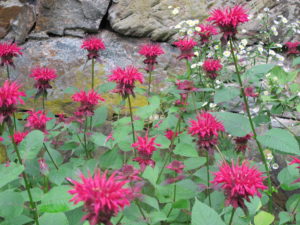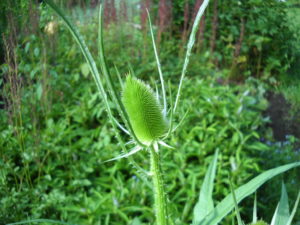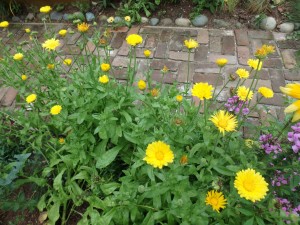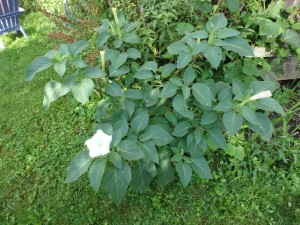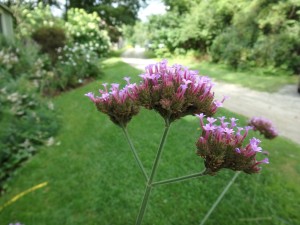When Good Flowers Get Out of Control
Every garden has a few thugs. Nice flowers with handsome blooms that somehow get too rambunctious and take over. They can choke out other plants as easily as weeds. That happens, in part, because we are reluctant to pull them. In general, they have roots that extend and send up new shoots. Let’s look at a few.
I recently pulled up a lot of beebalm (Monarda didyma). That was tough for me to do because it is such a great flower, and it has not yet bloomed. But it had run roughshod over most of one large flower bed, and it had to be brought under control.
Beebalm likes morning sunshine and soil that does not dry out completely. There is also a native beebalm (Monarda fistulosa) that I’ve seen wild in the Mid-west and Rockies. It is shorter, and has pale lavender colored flowers. It does well in hot, dry locations. Our garden beebalm comes in six or more colors from purple to pink – but it does best out of the hot afternoon sun. It sends roots up to a couple of feet, and because it is tall, it can shade-out and out-compete other flowers. As the Red Queen in Alice in Wonderland pronounce, “Off with her head!”
For removing any plant with extended roots, I like the CobraHead weeder. It is curved like a single steel finger, and can be used to loosen the soil under and around weed (or thug-like flower) roots. I gently tug on the flower stem, while loosening the roots. Beebalm, like most plants with long roots, has nodules in the roots. If you break the root, new plant stems will grow from a nodule.
Another difficult plant is Obedient Plant (Physostegia virginiana). What a funny name for a plant that is not the slightest bit obedient. Its roots are problematic because they break so easily, more so than any other plant I know. They send down a tap root that breaks off, even if you have loosened the soil. And it can take over a garden in just a season! I no longer allow it in any of my garden beds, but have moved some to the edge of the woods where deep shade on one side, and lawn on the other, can control it.
All that said, Obedient Plant is a lovely cut flower. It has strong square stems (like mints), and for me it grows up to 5 or 6 feet tall. It lasts well in a vase, with pink or white spikes of many small flowers. I had it in full sun in rich, moist soil, and it ran like crazy!
There is a form of Obedient Plant that has green and white leaves, and it is much more obedient! Like any variegated-leafed plant, this one has less vigor because it has less green chlorophyll to make the food that feeds the roots and flowers. I grow this one, though I find I often need to stake it to keep the flower stems from flopping over.
Another potential thug that I allow in my garden is common teasel (Dipsacus fullonum). Hated by corn farmers in the Mid-West as an invasive weed, it spreads by seed, not root. It’s a biennial. The first year of its life it does not flower, but produces distinctive long, light-green leaves (often with little wart-like bumps) in a low rosette. The second year it sends up a flower stalk up to 6 or 7 feet tall, and produces a seed head that is like a piece of sculpture.
Individual teasel flowers are very small and a light purple, but they don’t all appear at once. Bees love them! The seed head is very showy, a 2-inch spiny extravaganza that looks great in a vase as a cut flower, or later as a dried flower. I wear leather gloves to pick it, and then rub off the spines on the stems for use in vases.
The key to controlling teasel is to learn to recognize and pull the first year plants. That, and picking the stems with flowers before they distribute seeds. I suppose I will get e-mail telling me how stupid I am for allowing this thug in my garden, but I have been able to keep it under control – and I introduced it 20 years ago! Don’t introduce it to your garden unless you can pay attention to it, and keep it controlled.
Sometimes we make mistakes. We see a well-controlled plant blooming in its pot and buy one (or more). We put it in the garden, and only later decide that it has some bad qualities. It has taken me a long time to realize that it’s great to recognize that a plant is not for me, and then be able to dig it up and toss it into the compost.
I recently needed space for a new plant, and decided that I did not like my Siberian Bugloss (Brunnera siberica). I bought it because I have another species of Bugloss (B. macrophylla) that I like a lot. ‘Jack Frost’ Brunnera has lovely small blue flowers in spring and low green and white leaves all summer. But the Siberian relative does not stay in a compact mound, and is a bit floppy. So I yanked it in favor of something new.
Call me fickle if you wish, but I have a limited amount of garden space, and I reserve the right to remove any plant that does not, at least occasionally, cause me to say with glee, “I love that plant!”
Read Henry’s twice-weekly blog posts at https://dailyuv.com/
Free Flowers!
Right now my front walkway is dominated by annual flowers, many of them that I did not plant – not this year, anyhow. First and foremost are the calendula. These are wonderful bright yellow flowers in the composite family, like daisies or sunflowers. They blossom and then drop seeds on the soil so they come back every year.
To have a nice supply of calendula, all I had to do was leave some of the seedlings to develop this spring. The seedlings are easy to identify: their color is a bright green the color of young lettuce. I removed many, but left a dozen or so. Right now they are gorgeous.
Another of my annual favorites that seeds itself is a big, bodacious flower with white blossoms that are often more than 6 inches long and shaped like a trumpet: Angel’s trumpet or Datura. It comes in both white and purple forms, though I have not been impressed with the purple ones – they are much less vigorous, with fewer blossoms.
Angel’s trumpet is my substitute for Asiatic and Oriental lilies which I can no longer grow- they are consumed and ruined by an invasive red beetle. Unlike the true lilies, Angel’s trumpet is not bothered by the beetles and blooms all summer. I have read that the seeds and flowers are poisonous – they produce severe hallucinations. But the seeds come in spiny covering, so few kids or animals are likely to want to put them in their mouths.
When I see their distinctive leaves in the spring I move them to a place where I have space for a plant that is often 4 or 5 feet across and 2 to 3 feet tall. Some years I get plenty of “babies”, other years I do not. They grow best in full sun to part shade in rich soil that stays a little moist.
Also on my front walkway is a tall plant with tough, thin, wiry stalks that often reach 4 to 5 feet, Brazilian verbena (Verbena bonariensis). In our climate this is an annual, but back home in South America it is a perennial. It has reddish-blue flowers, usually in groups of 3 at the tops of the stems. It rarely needs to be staked.
Its spring leaves, important to recognize if you want free flowers, are in pairs with serrated edges and roughly the shape of an elongated tennis racket. Look hard at the leaves now, noting the color and texture – even though the mature leaves are greatly elongated.
Of course, if you want to get flowers to self-sow, you must allow seeds to fall on bare soil. Even a 1 or 2 inch layer of mulch will prevent most seeds from finding a home and growing. If you are well mulched, you will need to monitor the seeds so you can pull back the mulch and sprinkle some on the ground when they are brown and ripe.
But there are other ways to get lots of plants besides encouraging self-sowing. Some perennials spread by root, turning a small clump into a big one in now time at all. Bee balm (Monarda didyma) is one that is a well-known spreader. Of course it is a lovely flower and most of us are happy to have more. And it pulls up easily, so I don’t call it a thug. Mine do best in part sun – morning only – and soil that doesn’t dry out too much.
In a funny quirk of fate, one of the least obedient plants I grow is called obedient plant (Physostegia virginiana). This is a beautiful tall pink plant that grows and spreads like crazy! It is a great cut flower with square stems with little florets up and down it.
Here is what I recommend: If you want to grow obedient plant, put it in shade, and don’t give it too much moisture. I have it growing under a rosemary willow that has its lower branches pruned off, and it is lovely there. And if it grows towards the sun, it’s in the lawn where my mower will keep it line.
Obedient plant also comes in a form with green and white leaves. This spreads a little, but it is not a thug for me. Whenever you have white portions of leaves, the plant gets less food because there is no photosynthesis in the white parts. That will make them less able to survive our winters, too. Plantswoman Nina Klinck at E.C. Brown Nursery in Thetford, VT says, “A variegated leaf plant is one zone less hardy than the same plant with all green leaves.” I agree.
One last suggestion: Don’t fertilize thugs or any plants that might take off and run. The less nitrogen and other nutrients in the soil, the more likely it is that you can control overly vigorous plants. Even adding compost to the planting hole is giving it an advantage it does not need. Put a thug in dry, crummy soil and maybe, just maybe it will behave itself.
Read Henry’s blog twice weekly at https://dailyuv.com/



